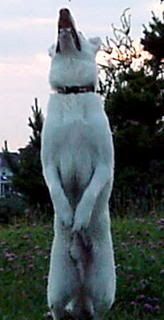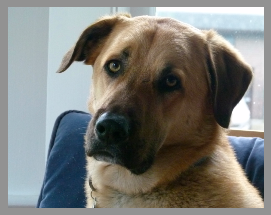I worked with a professional trainer this winter, and it is under her instruction that I am implementing the BAT technique and the halti collar. We haven't had a tune up for awhile, perhaps it is a good time to line up a session.
The puppy reactivity is not new. It was the first indicator that Jethro had reactive issues, when he was 6 months old and he reacted aggressively to two slightly younger pups. Since then we are very careful to keep our distance from puppies, it is a very difficult trigger to predict and work with.
Scent reactivity is not limited to puppies. He has also had over the top reactions to skunk, raccoon and coyote. Often I am guessing that is what is the source of the triggering scent, because there is no critter in sight. And yes, he can go into a full blown lunging and barking reaction on a scent, with no visible source. In fact, he will be scanning the environment, looking for the source.
His reactivity is not generalized, ie. his morning and midday walks are pretty much reaction free and he is much easier to handle. Evening walks are the worst. He is much more easily spooked by things at dusk, and there seems to be more things that are spooking him.
I have been implementing a three pronged approach (not with a prong collar). First, I work on managing his environment, to minimize Jethro's exposure to reactive triggers. I do this by circling (as per Turid Rugaas) potential difficulties like avoiding pedestrians or people walking with dogs. We use distance to keep Jethro far enough away from potential problems and then use that space to practice our OB with the distraction at a workable distance. I have used parked cars to shield us from a potential problem. I also ensure Jethro can't break free from me if he does have a reaction by wearing a large belt and clipping him to it. This has been very useful, for instance, there was a moment where two fire engines when screaming by with their sirens blaring and Jethro took a sudden leap away from me. I got a leash burn on my hand as it snaked out, but he was stopped up short because he was attached to me. I never go out without clipping him in for safety.
Second, I work with Jethro's OB, in situations with no or low distractions, continuing to build up his recall, Sit, Down, Leave It, Focus, and This Way are our standard repertoire. I also use Touch (both my flat palm and pointed finger), and Paw for more variety. For example, today on our walk we found a pile of raw meat sitting by the sidewalk. Yes, very odd! I used that situation to work on his Leave It command, using the clicker and treats, and using the meat as a decoy.
We also will practice a nice Sit and Focus if we can't get far enough away from a pedestrian, I put my body between Jethro and the passerby and ensure I have a good solid grip on his leash (it is loose but firmly held up close to his head).
I also use a non-verbal cue, with my pointed finger, to get him to go where I want him to go. I use this a lot around the house, when he is off leash. He will interrupt his barking and go where I tell him to, when we are on our property.
Third, I work on de-sensitizing with OB in varying levels of distraction. In a sense, we take what we are practicing at no or low distraction and look for 'teachable moments' on our walks. For example, on our walk this afternoon there was a big, new dog walking up toward us on the sidewalk. I initiated an evasive manoeuvre by crossing the street to the other sidewalk. Jethro saw the other dog, but was not aroused. Just as we got the other sidewalk, right in front of us, a squirrel charged across our path and up a tree. Jethro started at this sight, and I told him to Leave It. He looked at me and I told him to Sit, which I clicked and treated. Meanwhile, the big hound across the street was moving past us. I simply waited with Jethro in a Sit, while the hound moved past and the squirrel scampered high up into the tree. When all was calm, we moved forward with our walk.
I do believe our work with Jethro's reactivity was set back significantly because I used a prong collar on him for more than a year. The problem with the prong was that it was exacerbating his reactions. He has been doing much better on the halti head collar, which we started working with in early December.
Jethro is two years old, and I have been told that he will continue to test and push boundaries until he matures at three. Also, I am a new handler, learning with each passing day. Certainly his progress would look much different if any of the more experienced handlers on this board had been working with him since he was a puppy.
My question for this post was about desensitizing to scent triggers. I haven't seen much on this topic and I would like to add more techniques to my program. I would argue that there is a difference with different triggers in different situations. Yes, there is a common solution I am seeking - "Pay attention to me and leave that alone."
We have worked on visual triggers (a cat dashing across our path, a dog staring at us from across the street, little white dogs, etc.) and sound triggers (sirens, fire crackers, kids squealing, people shouting, etc). It is much easier for me to set up conditions for success with these things because I am perceiving pretty much what my dog is sensing. With scent it is different, he is having a very different experience through his nose and I am interested in ways to address that.
By the way, it was our first trainer that put Jethro on the prong, and later, when I explained why we had made the change, she agreed it was probably the right thing to do.
 Previous Topic
Previous Topic Index
Index Next Topic
Next Topic












 Top
Top







.jpg)

